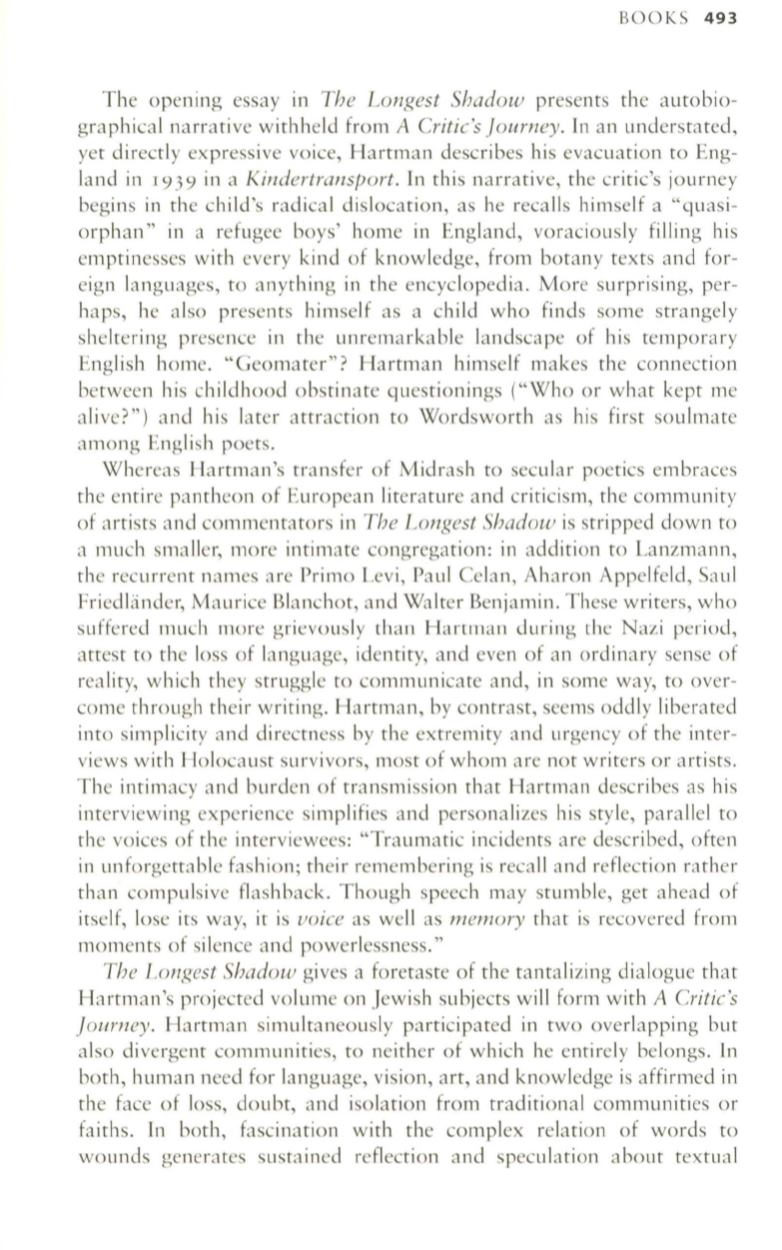
BOOKS
493
The opening essay in
The Longest Shadow
presents the autobio–
graphical narrative withheld from A
Critic's Journey.
In an understated,
yet directly expressive voice, Hartman describes his evacuation to Eng–
land in
1939
in a
Kindertransport.
In this narrative, the critic's journey
begins in the child's radical dislocation, as he recalls himself a "quasi–
orphan" in a refugee boys' home in England, voraciously filling his
emptinesses with every kind of knowledge, from botany texts and for–
eign languages, to anything in the encyclopedia. More surprising, per–
haps, he also presents himself as a child who finds some strangely
sheltering presence in the unremarkable landscape of his temporary
English home. "Geomater"? Hartman himself makes the connection
between his childhood obstinate questionings ("Who or what kept me
alive?") and his later attraction to Wordsworth as his first soulmate
among English poets.
Whereas Hartman's transfer of Midrash to secular poetics embraces
the entire pantheon of European literature and criticism, the community
of artists and commentators in
The Longest Shadow
is stripped down to
a much smaller, more intimate congregation: in addition to Lanzmann,
the recurrent names are Primo Levi, Paul Celan, Aharon Appelfeld, Saul
Friedlander, Maurice Blanchot, and Walter Benjamin. These writers, who
suffered much more grievously than Hartman during the Nazi period,
attest to the loss of language, identity, and even of an ordinary sense of
reality, which they struggle to communicate and, in some way, to over–
come through their writing. Hartman, by contrast, seems oddly liberated
into simplicity and directness by the extremity and urgency of the inter–
views with Holocaust survivors, most of whom are not writers or artists.
The intimacy and burden of transmission that Hartman describes as his
interviewing experience simplifies and personalizes his style, parallel to
the voices of the interviewees: "Traumatic incidents are described, often
in unforgettable fashion; their remembering is recall and reflection rather
than compulsive flashback. Though speech may stumble, get ahead of
itself, lose its way, it is
voice
as well as
memory
that is recovered from
moments of silence and powerlessness."
The Longest Shadow
gives a foretaste of the tantalizing dialogue that
Hartman's projected volume on Jewish subjects will form with A
Critic's
Journey.
Hartman simultaneously participated in two overlapping but
also divergent communities, to neither of which he entirely belongs. In
both, human need for language, vision, art, and knowledge is affirmed in
the face of loss, doubt, and isolation from traditional communities or
faiths. In both, fascination with the complex relation of words to
wounds generates sustained reflection and speculation about textual


